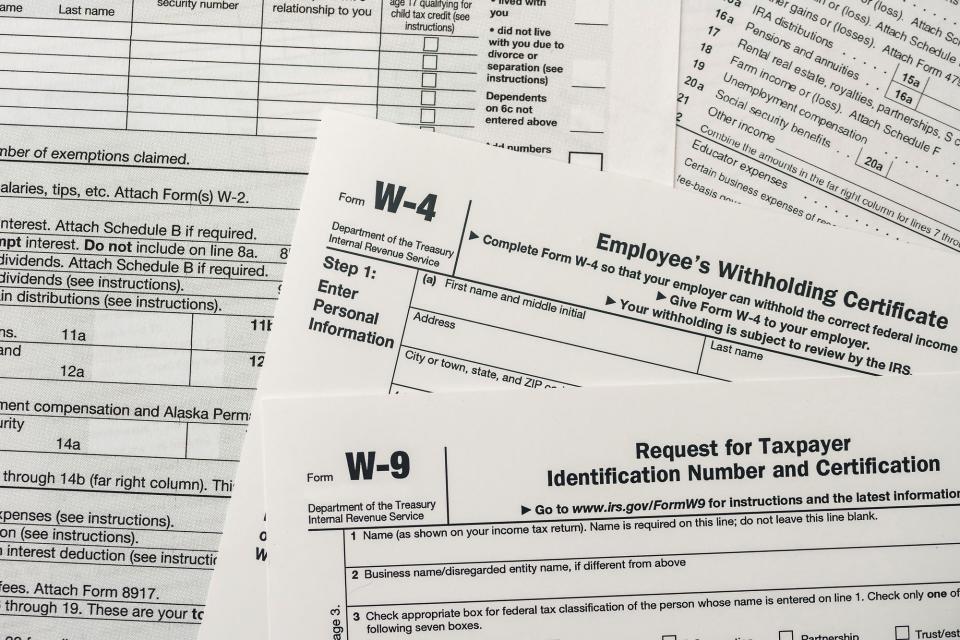W-9s and Four Other Business Tax Forms Entrepreneurs Need to Know About

Tax preparation is complex and often confusing, even when you’re filing individual income tax as an employee with a single source of income. When you’re a first-time entrepreneur, however, the complexity increases exponentially.
With so many income tax forms published by the Internal Revenue Service, and so much riding on getting your tax returns right, it’s important to understand what forms you’ll most often need and when to use them.
Related: 3 Ways Inventory Management Software Makes Tax Time Less Painful
From W-9s to 8829s, let’s look at a few of the major tax forms U.S.-based entrepreneurs need to be familiar with and use on a regular basis.
The W-9: Getting information from independent contractors
One of the best ways to get the specialized help you need for your small business without going to the considerable expense of hiring full-time or even part-time employees is to outsource projects to freelancers, consultants and companies. However, you do have to track these independent contractors properly and use their correct tax identification number (TIN).
The W-9 is the official IRS form that captures the accurate and official personal tax information for your contractor, including the TIN and the nature of the contractor (i.e., sole proprietor, S corporation, partnership, etc.).
All new contractors should submit completed W-9s to your finance department before beginning work on any contracts with your company. Also, it’s a good idea to periodically reach out to all your current contractors for updated W-9s in case any of their information has changed.
The 1099-MISC: Reporting what you paid independent contractors
If you’ve paid independent contractors (or certain other individuals) $600 for work performed in the current tax year, you’ll need to issue a 1099-MISC form for that contractor. This form captures what’s termed “miscellaneous income” in the form of rents, royalties and other types of income.
There are some exceptions to this rule so it’s important to double-check with the IRS or your tax attorney if you’re not sure whether a 1099-MISC is required. Getting a W-9 from all new contractors is a smart way to verify ahead of time whether you’ll need to send them a 1099.
Related: 5 Questions Entrepreneurs Should Ask Their CPAs to Reduce Audit Risk
Failure to submit a timely 1099-MISC to your contractors can result in some stiff fines and penalties. If you’re late, a fine of up to $100 per form may be assessed, and if you intentionally neglect to file the form, you may be on the hook for a $250 fine per form.
Note that there are other types of 1099 forms that may apply for your income tax return. These are all generally lumped under the “Information Returns” category by the IRS.
The W-2 and W-4: Employee tax statement and withholding allowance
The W-2 tax statement form reports your employees’ personal information as well as the precise sums paid to the worker for the prior year. It also reports all withholding, including Social Security, Medicare and income taxes.
Related: New Study: Health Care Is Freelancers' Biggest Concern
The W-4 form is called the “Employee’s Withholding Allowance Certificate.” Its purpose is to capture the number of allowances each employee claims they’re entitled to for withholding tax from paychecks. The form comes with detailed instructions for the employee to calculate allowances, deductions and other adjustments to the amount you, as the employer, will withhold from their wages or salary.
Form 8829: Claiming exemptions for home office expenses
If you’re self-employed and using your home as your office, you’re entitled to deduct the expenses connected with the business use of your home using Form 8829. The two requirements for claiming use of a home office are:
Regular and exclusive use: The area of your home in question must always and only be used for business purposes, though it doesn’t have to be a separate room.
Principle place of business: You must use this space a significant portion of the time your business is open. For example, if you meet clients elsewhere, but otherwise use your home office to conduct office-related tasks, you most probably meet this requirement.
There are two methods you can use to calculate these expenses. The simplified option allows a standard deduction of $5 for each square foot of your home used in conducting your business, up to a maximum of 300 square feet. The regular method requires you to report actual expenses and to maintain supporting documentation, such as receipts, bills, etc.
Knowledge is power
When it comes to taxes, the more you know now, the more you and your company are protected from unpleasant tax surprises in the future.
Of course, the forms discussed here don’t represent an exhaustive list. The IRS offers forms for everything from tax credits to charitable contributions. You should always consult official publications at IRS.gov or tax professionals if you have questions to make sure you’ve got a handle on all of your reporting obligations.


